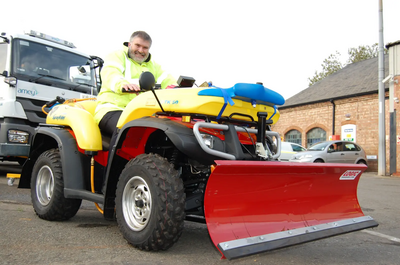COUNCIL PREPARED FOR WINTER WEATHER AS MAYOR UNVEILS LATEST WEAPON IN BATTLE TO KEEP BOROUGH MOVING

With winter fast approaching, Mayor Dave Hodgson has unveiled Bedford Borough Council's latest weapon in the Council's armoury to keep the borough moving during the cold months.
A specially equipped quad bike will be available to grit busy pedestrian areas, such as the town centre and other shopping parades as well as other narrow and hard to reach routes the gritting lorries cannot reach. This is all part of the Council's aim to keep the borough moving if another harsh winter arrives.
In addition to the new quad bike, Bedford Borough Councils 'Gritter Twitter' service is now up and running once again.
'Grittertweets' was launched last winter and provided daily updates on road conditions and informed followers when and where gritting crews will be salting roads throughout the borough.
However, these provisions would be nothing without the grit needed to treat our roads and pavements. That is why Bedford Borough Council has proactively sourced approximately 7,000 tonnes of grit, with a further 3,000 tonnes on order. In fact, the Council has secured so much grit in advance of the winter period the doors at the Twinwoods depot fell off!
The Council's winter maintenance webpage is also up and running. This provides information on weather conditions and gritting runs and also updates if school or adult transport services are affected by bad weather.
Mayor of Bedford Borough, Dave Hodgson, said: "The last two winters have seen incredibly harsh conditions in the borough, but thanks to early preparation and the commitment and dedication of front-line staff we were able to maintain services and to continue to grit a full network of road routes and heavily-used pedestrianised areas. We are committed to doing all we can this winter once again to keep the Borough moving, and have worked very hard in the warmer months to ensure we are fully prepared for the colder months.
"This year, I am delighted to announce we will also be using a specially equipped quad bike to grit pedestrian areas in the borough. This will allow us to effectively treat busy pedestrian areas such as shopping areas and keep pedestrians, as well as motorists, safe this winter.
"Our grittertweets and Winter Maintenance webpage will again return this winter. Each of these services proved to be helpful to a growing number of residents last year, keeping people up to date with the latest information on road conditions and any weather-related impacts on Council services, and we will once again be as open and responsive as we can in communicating during any periods of harsh weather."
Any questions on highways can be directed to the Highway Helpdesk on 01234 228661
The Council's grittertweets service is available at:
http://twitter.com/#!/grittertweets
The winter maintenance webpage is available at:
http://apps.bedford.gov.uk/winterupdates/#1
Interesting Facts
Gritting of Bedford Borough's roads
Bedford Borough Council is responsible for salting roads when temperatures drop below zero to make sure all main routes on the network are safe and clear of snow and ice. We will also clear any snowfall and help keep local roads safe and clear for drivers.
When do we salt?
Salting is carried out when road temperatures are expected to drop below zero and when the roads are expected to be damp. Ice will not form on a dry road surface in a dry atmosphere. We try to carry out salting either after the evening or before the morning peak traffic periods. However, during adverse weather conditions, we may have to salt at other times, even 24 hours around the clock if we have heavy and continuing snow.
How do we know when to salt?
We use a computer system that collects weather and road information at different sites across the Borough. It also tells us if any salt is left on the road from previous salting. This enables us to use salt as wisely as possible.
The Met Office use this information along with their other weather data to predict weather conditions and road surface temperatures across the Borough (see forecast text above).
It is on this information that we base our decision on whether to salt or not and at what time of the day or night.
What roads do we salt?
A salting network of roads has been created so that roads carrying the highest amount of traffic and with the highest risk of accidents are treated. This means that just under half of the road network is salted. All A and B roads are salted along with other important local roads. We also try to ensure that the majority of road users live within a reasonable distance of a salted route.
In prolonged snow and ice, additional roads may be treated, but only when the normal salting network shown on the map is relatively clear of ice and snow.